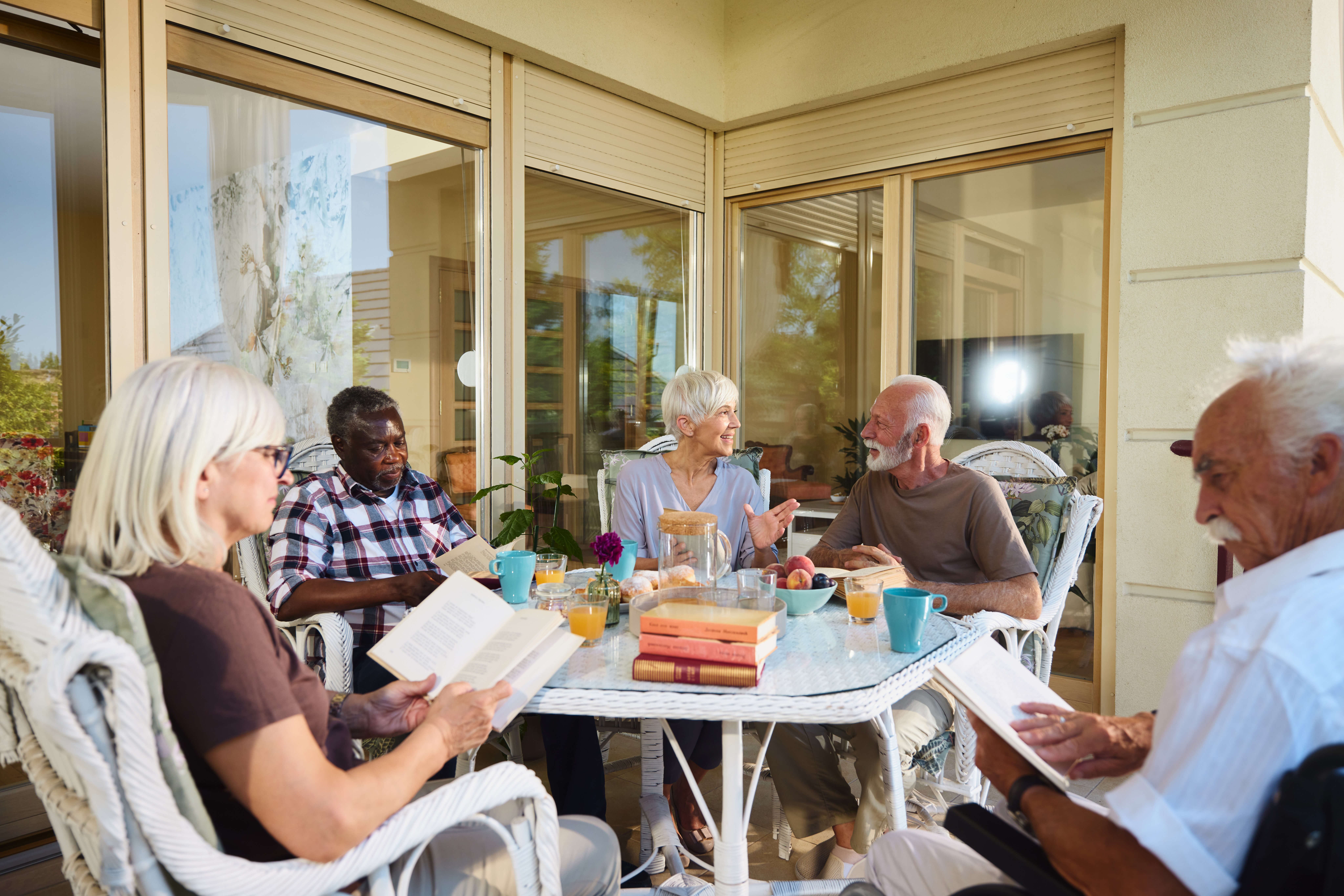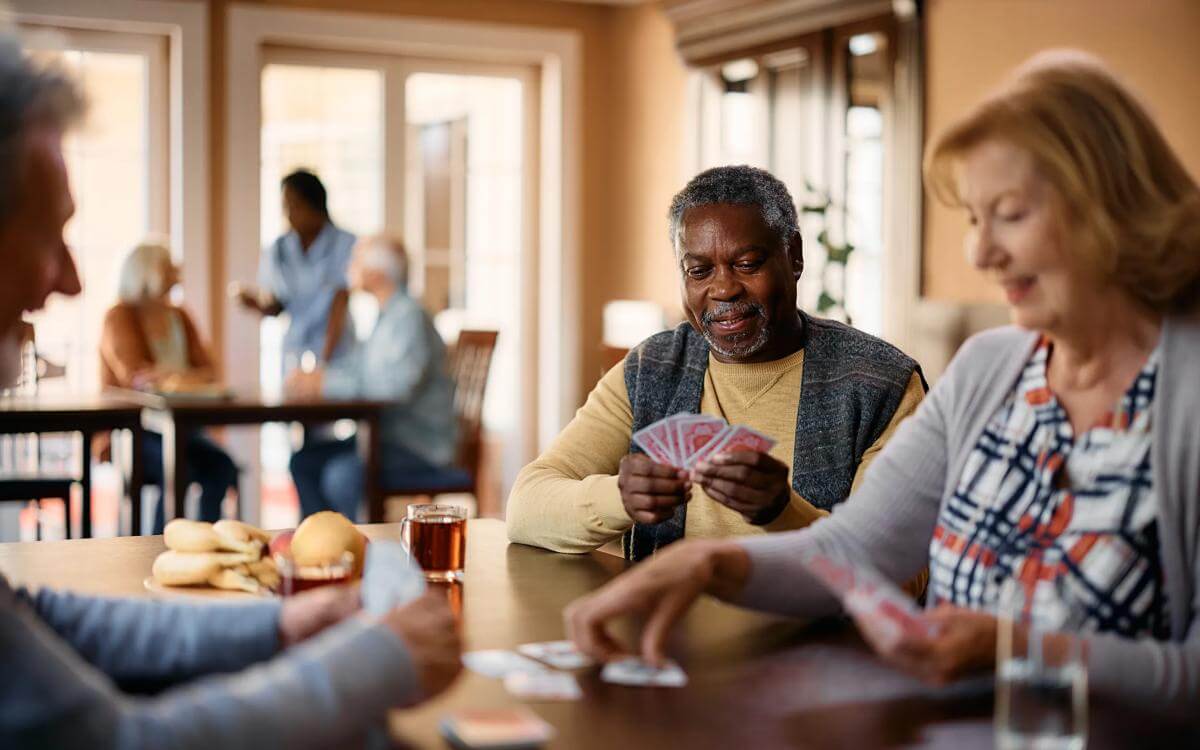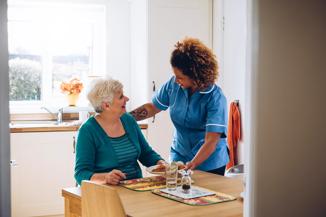To meet the needs of an ageing population, the range of later living housing options continues to expand.
Understanding the different types of housing targeted at older people can help individuals and families make informed decisions about future accommodation needs, whilst also informing policy makers, and also developers and investors about market opportunities.
Here, we take a look at some of the different types of later living housing options.
Independent retirement housing
Independent retirement housing, sometimes called sheltered or retirement housing, represents the purpose-built later living accommodation that many people have an awareness of. These developments, which typically comprise 40 to 60 self-contained homes, are designed specifically for people aged 55 or over, who wish to maintain their independence while benefitting from age-appropriate design and optional support services.
Key features include:
- Age-restricted sales or lettings: Typically 55+ or 60+ to ensure a community of peers.
- Accessible design: Level access, wider doorways, accessible bathrooms and lift access to upper floors.
- Emergency alarm systems: 24-hour monitoring systems connected to each property.
- Communal facilities: Residents' lounges, guest suites, laundry facilities, and sometimes gardens or roof terraces.
- House manager or scheme co-ordinator: On-site staff member who provides assistance with day-to-day issues and co-ordinates services.
- Secure entry systems: Controlled access to buildings and often CCTV monitoring.
Independent retirement housing is often purchased on a leasehold basis, with some providers offering shared ownership, with service charges covering communal area maintenance, emergency monitoring and staff costs. Some operators do offer homes on a rental basis and some offer outright sales of the freehold
Residents retain full independence, coming and going as they please, whilst benefitting from the security and community aspects of a purpose-built accommodation scheme.
Integrated retirement communities
Integrated retirement communities (IRCs), also known as retirement villages, are a newer product in the UK, although very common in the US, Canada, Australia and New Zealand. These typically large-scale developments house several hundred residents sometimes across different accommodation types such as apartments, bungalows, cottages and townhouses. Some also have a care home located on the site.
They tend to be seen more as an all-round lifestyle offering. As the name suggests they integrate lifestyle facilities and in some cases care services into the villages and they often seek to integrate the village with the local community, by for example making some of the facilities, such as restaurants open to the wider public.
Key features include:
- Extensive amenities: Restaurants, bars, fitness centres, swimming pools, libraries, shops and entertainment venues often also open to the public.
- Lifestyle and wellness programmes: Organised activities, educational courses and social clubs.
- Accessible design: Level access, wider doorways, accessible bathrooms and lift access to upper floors.
- Age-restricted sales or lettings: Typically 55+ or 60+ to ensure a community of peers.
- Emergency alarm systems: 24-hour monitoring systems connected to each property.
- Scheme manager: On-site staff who provide assistance with day-to-day issues and co-ordinates services.
- Secure entry systems: Controlled access to private buildings and often CCTV monitoring.
- Multiple accommodation types: Independent apartments, and in some cases assisted living units and care facilities all within one development.
- Continuing care model: In some cases residents can move between different levels of care within the same community as their needs change.
Community and lifestyle focus
IRCs – like the one depicted in bestselling book and Hollywood film The Thursday Murder Club – often emphasise active ageing and community engagement, with extensive programmes of activities, learning opportunities and social events.
The scale of these developments allows for sophisticated amenities that wouldn't always be viable in smaller schemes, creating environments intended to enhance all round quality of life.
The continuum of care
What distinguishes some IRCs is their ability to provide a complete continuum of care and accommodation.
Residents might begin in independent apartments, progress to assisted living with care packages, and eventually move to on-site care facilities if needed – all while remaining within the same community and maintaining established relationships.
Care and support services may include:
- Flexible care packages: Care and support tailored to individual needs, which can be adjusted as requirements change. Some can include specialist care and support, such as dementia care.
- 24-hour care staff presence: Qualified care staff available around the clock in supported areas.
- Technology integration: Assistive technology, telecare systems and digital health monitoring.
- Healthcare integration: Some schemes include on-site healthcare services such as GP surgeries or physiotherapy.
These retirement villages aims to create a complete lifestyle offering that can adapt to residents' changing needs over time, from active independent living through to end-of-life care, all within the same community setting.
This model is particularly appealing to couples where partners may have different care needs, as it allows them to remain close whilst receiving appropriate levels of support.
IRC homes are either purchased on a leasehold basis, with some providers offering shared ownership, with service charges covering communal area maintenance, emergency monitoring and staff costs; or, are rented.
Care homes
Care homes provide accommodation and personal care for people who can no longer live independently, even with support services.
This category encompasses residential care homes, nursing homes, and specialist care homes which together serve people with varying levels of care needs.
Residential care homes
Residential care homes provide accommodation and personal care for people who require regular assistance with daily living activities but do not need nursing care.
Key characteristics include:
- 24-hour care provision: Qualified care staff available at all times.
- Personal care services: Assistance with washing, dressing, eating and mobility.
- Medication management: Trained staff administer and monitor medications.
- Communal living: Shared dining rooms, lounges and activity spaces.
- Individual bedrooms: Most modern care homes provide en-suite facilities.
- Regulated environment: Subject to regular inspections and quality monitoring by the Care Quality Commission.
Nursing homes
Nursing homes provide the highest level of care accommodation, combining residential care with 24-hour nursing care for people with complex health needs.
Additional nursing home features include:
- Qualified nursing staff: Registered nurses available 24 hours a day.
- Medical equipment and facilities: Specialist equipment for complex care needs.
- Healthcare partnerships: Close working relationships with GPs, consultants and other healthcare professionals.
- End-of-life care: Palliative and hospice care services.
- Therapy services: Physiotherapy, occupational therapy and speech therapy.
Specialist care provision
Within the care home category, many facilities specialise in particular types of care.
Dementia care facilities provide secure environments with specialist staff training, adapted design features, and therapeutic programmes specifically for people living with dementia. These may be dedicated dementia care homes or specialist units within general care homes.
Specialist nursing homes may focus on particular conditions such as neurological disorders, brain injuries, or complex continuing healthcare needs, providing highly specialised care and equipment.
Care home environment and quality of life
Modern care homes increasingly focus on creating homely environments that promote dignity, choice and quality of life. This includes:
- Person-centred care: Care plans tailored to individual preferences, histories and needs.
- Activities and engagement: Programmes designed to maintain cognitive function and social interaction.
- Family involvement: Encouraging family participation in care and decision-making.
- End-of-life care: Ensuring dignity and comfort in final stages of life.
Tenure and funding models
Later living housing operates under various tenure and funding arrangements that differ across the three main types.
Independent retirement housing
- Leasehold purchase: Buying a lease on a property, typically for 99 years or more, with ongoing service charges.
- Shared ownership: Purchasing a percentage of a property and paying rent on the remainder.
- Rental accommodation: Both social housing providers and private operators offer rental options.
Integrated retirement communities
- Leasehold purchase: Buying a lease on a property, typically for 99 years or more, with ongoing service charges.
- Shared ownership: Purchasing a percentage of a property and paying rent on the remainder.
- Rental accommodation: Both social housing providers and private operators offer rental options.
- Deferred Management Fees: Some operators offer arrangements where residents pay lower monthly charges in exchange for a lump sum payment out of proceeds of sale from their unit when it is resold.
Care homes
- Self-funding: Residents pay fees from their own resources, including property sales.
- Local authority funding: Means-tested support for those with limited resources.
- NHS continuing healthcare: Full funding for those with complex health needs.
- Mixed funding: Combinations of self-funding and state support.
Retirement planning considerations
When considering later living housing options, the following are suggestions of some factors that may be taken into account. It is important to recognise, though, that everyone is different and where someone chooses to live is a very personal matter.
Progression planning: Understanding how each option accommodates changing needs over time. Independent retirement housing may require future moves, while some integrated retirement communities may offer progression within the same location.
Location and accessibility: Proximity to family, friends, healthcare services, shops and public transport links.
Financial implications: Understanding all costs, including purchase prices, service charges, care fees and potential exit fees.
Community and lifestyle: The social environment, activities available, and compatibility with personal preferences and values.
Care philosophy: Understanding the approach to care and support.
The evolving landscape
The later living accommodation sector continues to evolve, with boundaries between the three main categories – independent retirement housing, integrated retirement communities and care homes – becoming increasingly blurred.
Some independent retirement housing schemes are adding more comprehensive services, while new integrated retirement communities are developing innovative care models.
Technology integration is transforming all types of provision, enabling more sophisticated approaches to health monitoring, care delivery and community engagement. Artificial intelligence and assistive technology are beginning to supplement traditional care models, potentially allowing people to remain independent for longer while ensuring safety and wellbeing.
The sector is also responding to changing consumer expectations, with newer developments focusing on lifestyle, wellness and active ageing, rather than simply providing accommodation and elements of care. This shift is particularly evident in integrated retirement communities, which increasingly market themselves as lifestyle choices rather than care solutions.
Understanding these three main categories and their variations is crucial for individuals planning their later years, families supporting older relatives, and professionals working in housing, care and related sectors.
As the sector continues to develop, the quality and sophistication of options within each category will likely continue to improve and we will see more variations, offering greater choice and flexibility for the UK's ageing population.
Contents
Contact

Victoria Thourgood
Partner
victoria.thourgood@brownejacobson.com
+44 (0)330 045 2208
You may be interested in...
Press Release
Browne Jacobson corporate health partner recognised as ‘one to watch’ at national industry awards
Opinion
The Thursday Murder Club: Resetting the narrative on retirement living
Guide
Understanding the different types of later living housing
Guide
Later living housing: Meeting the challenge of an ageing society
Published Article
The critical role of ‘rightsizing’ for an ageing population
Press Release
Browne Jacobson report sets out how care sector can future-proof workforce as visa changes restrict
Legal Update
Workforce strategies for care providers: Future of Care roundtable report
On-Demand - Care Focus webinar series
Care Focus: Critical incident - Reflection
Guide
Inquests: How wide should the scope be? The coroner’s decision
On-Demand - Shared Insights
Shared Insights safeguarding forum: Focus on self-neglect
On-Demand - Care Focus webinar series
Care Focus: Critical incidents and managing risks
On-Demand
Shaping a culture of respect and harmony: Managing competing beliefs
On-Demand - Care Focus webinar series
Care Focus: Critical incident inquests
Legal Update
HMRC briefing on VAT groups in residential care: Concerns and actions
On-Demand - Care Focus webinar series
Care Focus: Regulatory and employment
Legal Update
LGBTQ+ inclusion in adult social care: Addressing inequalities and driving change
On-Demand - Care Focus webinar series
Care Focus: Critical incident response and criminal investigations
On-Demand - Care Focus webinar series
Care Focus: The crucial first 48 hours
Press Release
Health and life sciences: 2025 predictions
Press Release
Comment on Older People's Housing Preferences report
Press Release
Comment on Older People's Housing Taskforce report
Legal Update
PPU roundtable 1: Expanding your private patients unit roundtable
Press Release - Firm news
Browne Jacobson launches new HR services offering in health and social care
Press Release
Better financial and data management can improve resilience and support growth for care providers
Legal Update
Inquests and Article 2 of the ECHR: A practical guide following the case of Maguire
Press Release
Law firm champions social care as thousands of care homes set to open their doors
Legal Update
Retirement housing: A solution to our care and housing crises?
Press Release
Law firm launches new Health and Care Connect forum for the independent health and care sector
Press Release
Browne Jacobson advise Charterpoint on development plans for local centre and care home in vibrant Leicestershire community
Browne Jacobson has advised Nottingham based developer Charterpoint on its joint development plans with landowner Drummond Estate on land at New Lubbesthorpe, a vibrant new community located in Blaby, Leicestershire.
Press Release
Browne Jacobson advises Charterpoint on sale of 73-bed care home site
Browne Jacobson has successfully advised Nottingham based developer Charterpoint on the sale of a 1.2 acre care home development site in Thurnby (Leicestershire) to care home operator Cinnamon.
Legal Update
When does the treatment of residents of care homes meet the article 2 and article 3 thresholds?
Residents of care homes are particularly vulnerable members of our society, with higher risks of incidents and fatal injuries, which unfortunately can be as a result of suffering ill-treatment. Courts can be faced with the difficult task of determining whether the treatment amounts to a breach of the individual’s rights.
Opinion
Care home worker fairly dismissed for refusing Covid-19 vaccination
The Tribunal considered whether a care home worker was unfairly dismissed following her refusal to be vaccinated against Covid-19. It is important to note the Claimant’s dismissal pre-dated the compulsory vaccination regulations in force from November 2021.
Press Release
Browne Jacobson’s real estate team advise Charterpoint on sale of Lincolnshire land for build of 40 new homes
Browne Jacobson’s national real estate lawyers have advised Nottingham based developer Charterpoint Developments on the sale of land in Louth, Lincolnshire to Snape Properties.
Legal Update
Compulsory Covid-19 Vaccinations in Health and Social Care Settings
Practical steps health & social care employers can take now to prepare for compulsory Covid-19 vaccinations.
Opinion
Potential care home vaccination challenge
Time is rapidly running out for those who will fall within the mandatory vaccination requirements applying to care homes from 11 November 2021 and who remain unvaccinated from Covid-19.
Opinion
Compulsory vaccinations in care homes
Care homes will need to take steps to assess the impact of these Regulations on their workforce.
Legal Update
Care Quality Commission (CQC) prosecution outcomes highlight ongoing trends
Legal Update
Investing in distressed care homes: Diamonds in the rough or a lost cause?
The Covid-19 pandemic has given operators and investors in the care home market new factors to consider when assessing acquisition targets.
Press Release
Browne Jacobson advises developer on sale of 66 bed care home site
Browne Jacobson’s real estate team have advised developer Charterpoint on the sale of a 2.2acre site at Westfield Park in Louth earmarked for a 66-bed care home to LNT Care Developments Ltd.
Legal Update
Dissipation of assets to avoid care home fees
We have seen an increase in local authorities contacting us asking for advice about dissipation of assets in the context of care homes/nursing homes fees.





























